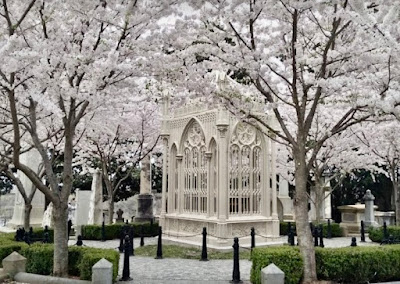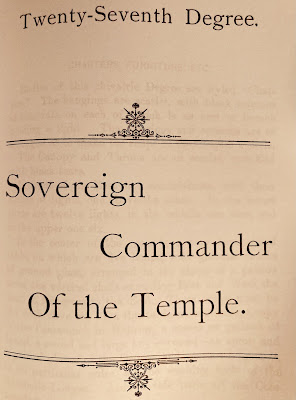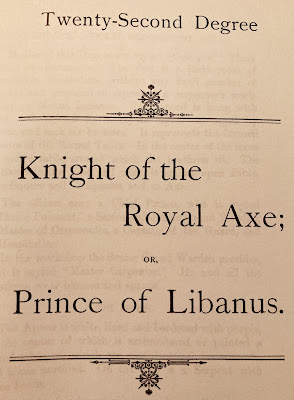 |
| Daniel D. Tompkins |
On this date in 1774 was born a great, if historically overlooked, American man and Mason: Daniel D. Tompkins. Biographical highlights include being made a Freemason at Hiram Lodge 72 in Westchester County (later affiliating with Salem 74); serving as Grand Secretary of our Grand Lodge; and becoming the first Sovereign Grand Commander of the Scottish Rite Northern Masonic Jurisdiction. Oh, and he was governor of New York (1807-17) before becoming the sixth vice president of these United States (1817-25). He died June 11, 1825 and was buried in Manhattan.
While George Washington is credited for transcribing a seventeenth century book of ethics into his personal journal as a boy, Daniel Tompkins composed a series of philosophical essays while a student at Columbia College. He addressed moral quandaries that impacted American life at the close of the 1700s, from slavery to capital punishment to how best to select government officials. He also expounded on matters of personal growth: education, honesty, prejudice. These essays, some of them fragmentary because of the vicissitudes of time, were anthologized for a book published by Columbia University in 1940 under the title A Columbia College Student in the Eighteenth Century. (The originals are found in the State Library in Albany.)
Of course this is long out of print—I can’t imagine a student at Columbia today even picking up this book with a pair of tongs—so I share brief excerpts here to remember how serious a young mind can be. Daniel Tompkins was a credit to our nation and to our gentle Craft. (I leave it to you to read of how he came to die tragically.)
The only criterion I know of by which to judge of the expediency of electing a man that has filled a station is to inspect into his former conduct. Has his aim hitherto been the good of the people? We may then reason from analogy that such will be his conduct hereafter. In fine so long as the people hold in their hands the chastening rod, the freedom of frequent elections [and] the right of making a change, we need not fear but that the officer will endeavor to secure the happiness and liberty of his constituents.
On Choosing Public Officials, 1792.
’Tis true that many valuable authors have written in the dead languages but I doubt whether there are not equally celebrated ones in the English and French languages and equally valuable…. If four or five years of Virgil’s early life had been spent in the study of languages other than his own, we should not have been favored with such excellent poetry from him so early as his twenty-fourth year.
On the Study of Dead Languages, 1792.
Happy for America that she has been successful in her struggle for Liberty, but unhappy that she has not fully completed her design although it was in her power to have done it. It would seem that the inhabitants of this Country have not that innate love for Liberty which many of them profess; otherwise we should not behold our fellow creatures in Slavery when it is in our power to relieve them. Liberty naturally fits and qualifies us for improvement in knowledge and knowledge allures us to, and gives us a relish for “the ineffable delights of sweet humanity.” Among those who are free and enlightened, if one man promote the happiness of another, his own delight is increased in the same ratio; and no man can enjoy real felicity whilst he beholds others miserable.
On Slavery 1, 1793.
In short if we look into the world, we shall find few men utterly free from prejudice of one kind or another. Local attachments, habit and the like frequently beget and nourish prejudice. I know many who are of this and the other profession in Religion and [profess] a substantial reason for it too, to wit, that their fathers before them were of the same profession. Yet subject as we all are, to be duped by Prejudice, the least appearance of it in others excites our disgust. When we find the historian swayed by prejudice in the relation of facts all our pleasure of reading him is diminished.
On Prejudice, 1794.
In society, every member is bound by the most sacred ties to preserve Harmony and the Tranquility of all the community. This consideration sufficiently evinces the perniciousness of Dishonesty. Besides whatever success Knavery may find for once, it will find it difficult to succeed a second time, for one imposition places all on their guard, and affixes a mark of infamy, which causes the person to be universally shunned. Prodigality generally accompanies dishonesty; and soon consumes what an act of Knavery has acquired. He is therefore reduced to the necessity of having recourse a second time to dishonesty. But as I said before, he will find all prepared for his attack—and even tho’ he should find it necessary to deal for once with probity, he will find none to negotiate with him. For when the wind blows from one quarter we commonly expect it to continue there for sometime.
On Dishonesty and Extreme Indulgence, 1794.
In short, whether Law, Divinity or Physic be your aim—whether Agriculture or Trade is to be made a science, there may you lay the foundation to advantage. Go on then students of Columbia, with eminence and glory in your view. In this land of liberty and peace, genius may extend her wings, unshackled by the restraints of arbitrary power. And real fame, true and lasting honor, belong only to the virtuous and the good. With tender wishes for your prosperity and happiness, we bid you…be virtuous! Be happy.
Valedictory Oration, May 6, 1795.




















































































